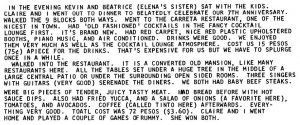Throughout the blog, you have probably noticed the various records we use to tell the stories of Peace Corps Volunteers. This post highlights some of the more common types of records that volunteers donate and record their experiences with.
The most common type of record that PCVs donate that tell their story is letters. Volunteers send correspondence back and forth with their family and friends for two years in which they express their accomplishments, frustrations, and describe their everyday life. A letter like the one below, air mail, was a familiar sight for families as it was the fastest and most common way volunteers sent letters.

Joyce Emery Johnston served in the Philippines in Education from 1965-1967.
Similar to correspondence is volunteers’ journals or diaries. These are where volunteers write more in depth about their daily activities and daily thoughts. Diaries are used to preserve memories, and some volunteers even start keeping diaries in the language of their host country as seen below.

David Day served in Kenya and India in Agriculture from 1965-1967.

David Day served in Kenya and India in Agriculture from 1965-1967.
A way that volunteers formally share their experiences is through memoirs. Alan Crew compiled his memoir as a gift to his son upon his graduation from college. In it he details his life in Nigeria and includes pictures of where he worked.
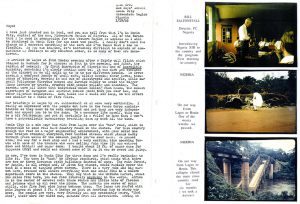
Alan Crew served in Nigeria in Education from 1965-1966.
Along with writing, volunteers also take many photos during their service to show their friends and families where they work and live. While most volunteers take regular digital photos, many early volunteers also used slides.

Patricia Kay served in Kenya in Education from 1966-1968.
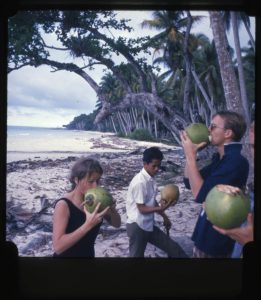
Patricia Kay served in Kenya in Education from 1966-1968.
Volunteers also send home postcards when they travel or want to share more photos of their host country.
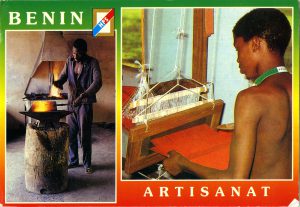

Tina Singleton served in Benin in Health Education from 1992-1996.
Along with these records, some volunteers also take videos of their service experience. The video below was taken by Brian Adler who served in Suriname with his wife Cindy from 2002-2004. In this clip he gives a tour of where he and Cindy lived, and the video goes on to show a village party, soccer game, and conversations with the villagers.
Bryan and Cynthia Adler in Marchall Kreek
For volunteers who either could not write home or found this method easier, they recorded audio tapes. This audio clip is from Richard Holmquist to his fiance Ann. In the full recording, he discusses his work as a professor at UMBC, how he met Ann, and what he did in Nigeria from 1966-1968. In this clip he discusses a need in Nigeria for lifeguards. (play button is on the far left).
Along with these personal records, Peace Corps Volunteers also donate some of their official Peace Corps paperwork. These include certificates of training and service completion, letters of service acceptance, and volunteer ID cards like Debby Prigal’s below.
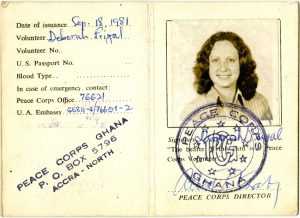
Debby Prigal served in Ghana in Education from 1981-1983.
The Peace Corps Community Archives holds many other different types of records such as architectural drawings, posters, newspapers, training materials, correspondence from the Peace Corps and various governments, and much more. But the handful of records highlighted here are the main forms of learning about what a Peace Corps Volunteer experienced while abroad.





